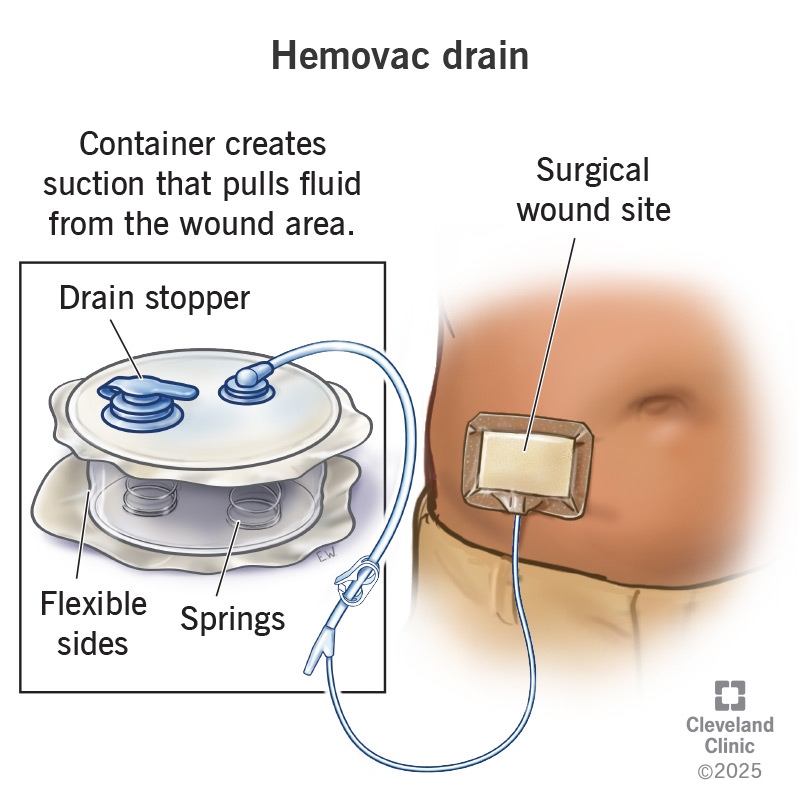A Hemovac drain removes fluid that can collect at the area in your body where you had surgery. Healthcare providers may insert the drain if you have abdominal surgery or other major surgery types. It consists of a tube that runs from the surgery site to a container. The drain uses negative pressure to pull out fluid. You empty the drain twice a day.
Advertisement
Cleveland Clinic is a non-profit academic medical center. Advertising on our site helps support our mission. We do not endorse non-Cleveland Clinic products or services. Policy

A Hemovac drain is a device that removes fluid from surgical wounds. It consists of a thin tube that runs from the area of the surgical wound to a small container. The container creates suction that pulls fluid from the wound area.
Advertisement
Cleveland Clinic is a non-profit academic medical center. Advertising on our site helps support our mission. We do not endorse non-Cleveland Clinic products or services. Policy
Draining fluid from a surgical wound area reduces the risk of a surgical site infection. The drain stays in place after you go home. You wear the drain under your clothes. You may need to keep the drain in place for several days up to two weeks after your surgery.
Your surgeon or a care team member will remove the drain as part of your follow-up care. You’ll need to care for the drain until your surgeon or care team member removes it.
You may feel anxious about keeping the drain working like it should. Your care team will explain how to take care of the drain, the incision and your surgical wound.
Surgeons often use Hemovac drains to support recovery after procedures like:
A Hemovac drain is a type of closed drain. That means it uses negative pressure to pull fluid from a surgical wound. Negative pressure works by creating a difference in air pressure. The difference is how the tube pulls fluid from the surgical wound.
Advertisement
Hemovac drain containers have flexible sides and springs inside. You create negative pressure when you push on the drain sides, so they squeeze together. This creates a difference in air pressure so the tube in your surgical wound can pull fluid into the container.
Your care team will show you how to care for the Hemovac drain and the area around the drain tube. They’ll also give you written directions to follow. Don’t hesitate to ask questions if you don’t understand any part of the process.
You’ll need to collect fluid from the drain twice a day. If possible, try to drain the Hemovac at the same time each day.
The first step is to collect the supplies you’ll need, including:
The next step is simple but very important: Wash your hands. You may use an alcohol-based hand sanitizer to clean your hands. Clean hands reduce the risk of infection.
To empty the container, you:
Your care team may tape gauze dressing over the spot where the tube enters your skin. You should change that dressing at least once day or if it gets wet. You’ll need to remove the dressing and clean the area around the drain tube after you empty the container. To do that, you:
Call your care team or your surgeon if:
Both drains use negative pressure to draw fluid from surgical wounds. The main difference is that a Hemovac drain can hold more fluid than a Jackson-Pratt drain. A Hemovac drain holds about 500 milliliters (mL). A Jackson-Pratt drain holds about 25 to 50 mL.
Advertisement
If you’ve had major surgery, taking care of a Hemovac drain may be part of your recovery. The drain is there to help your body heal. You may wonder if you’re up to the job. That’s a normal reaction. Your care team will understand if you need to double-check instructions with them. Don’t hesitate to ask if you’re not sure the drain is working properly.
Advertisement
Sometimes you have surgery planned. Other times, it’s an emergency. No matter how you end up in the OR, Cleveland Clinic’s general surgery team is here for you.

Last reviewed on 10/15/2025.
Learn more about the Health Library and our editorial process.